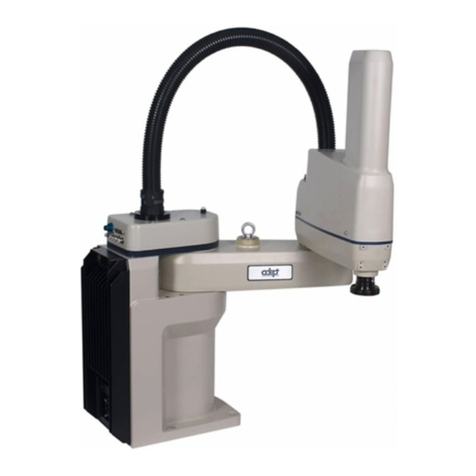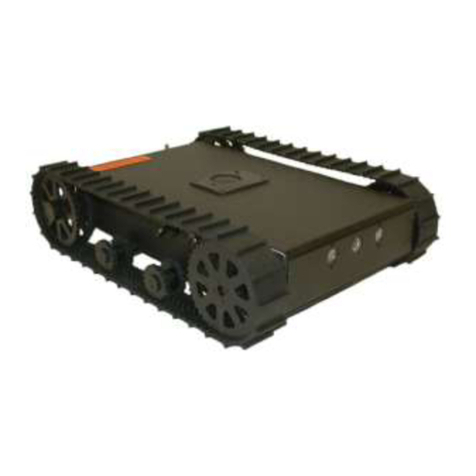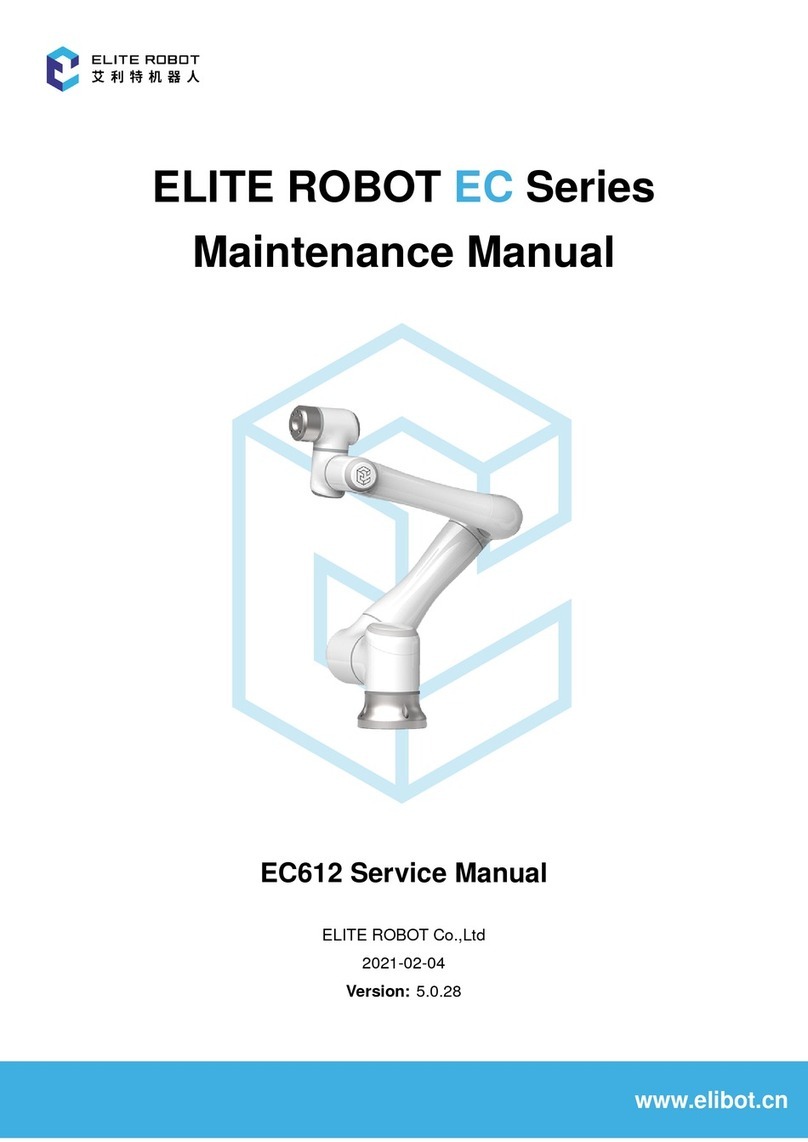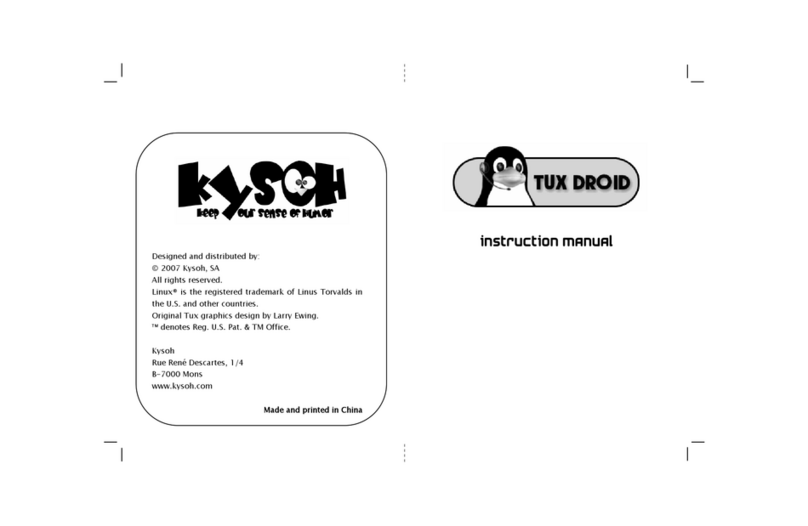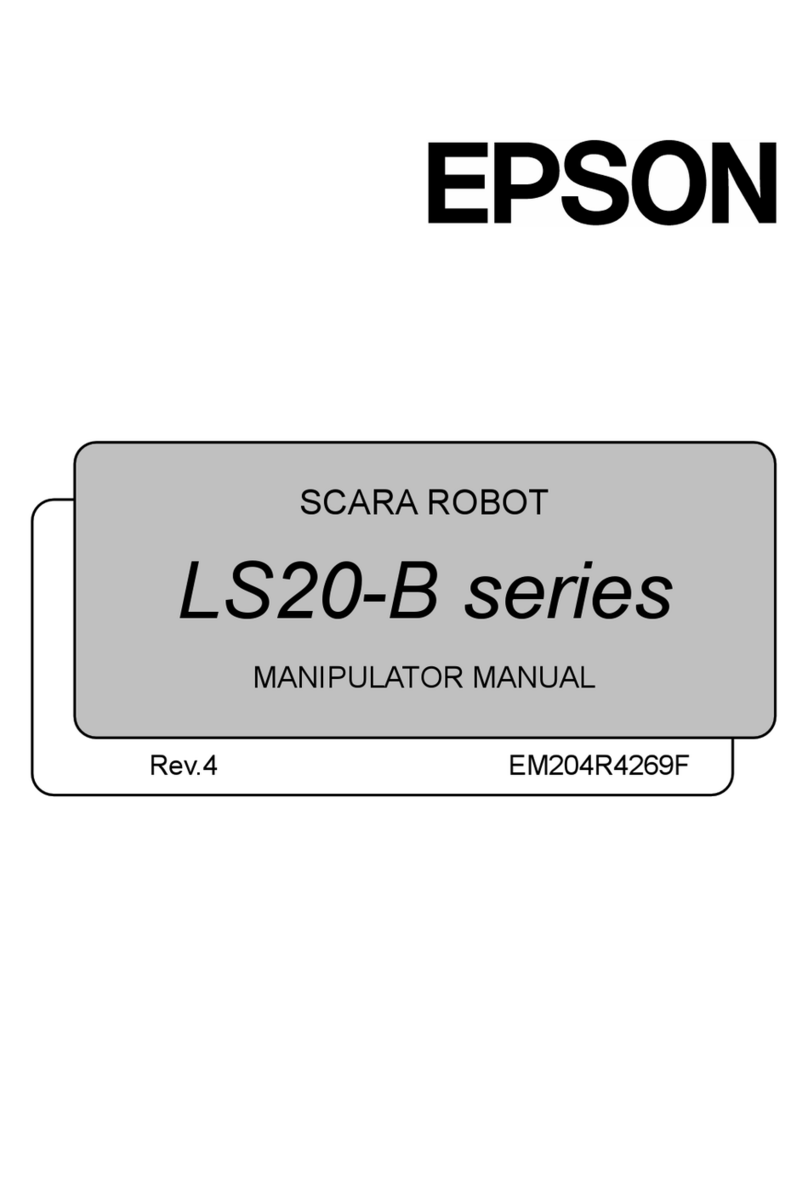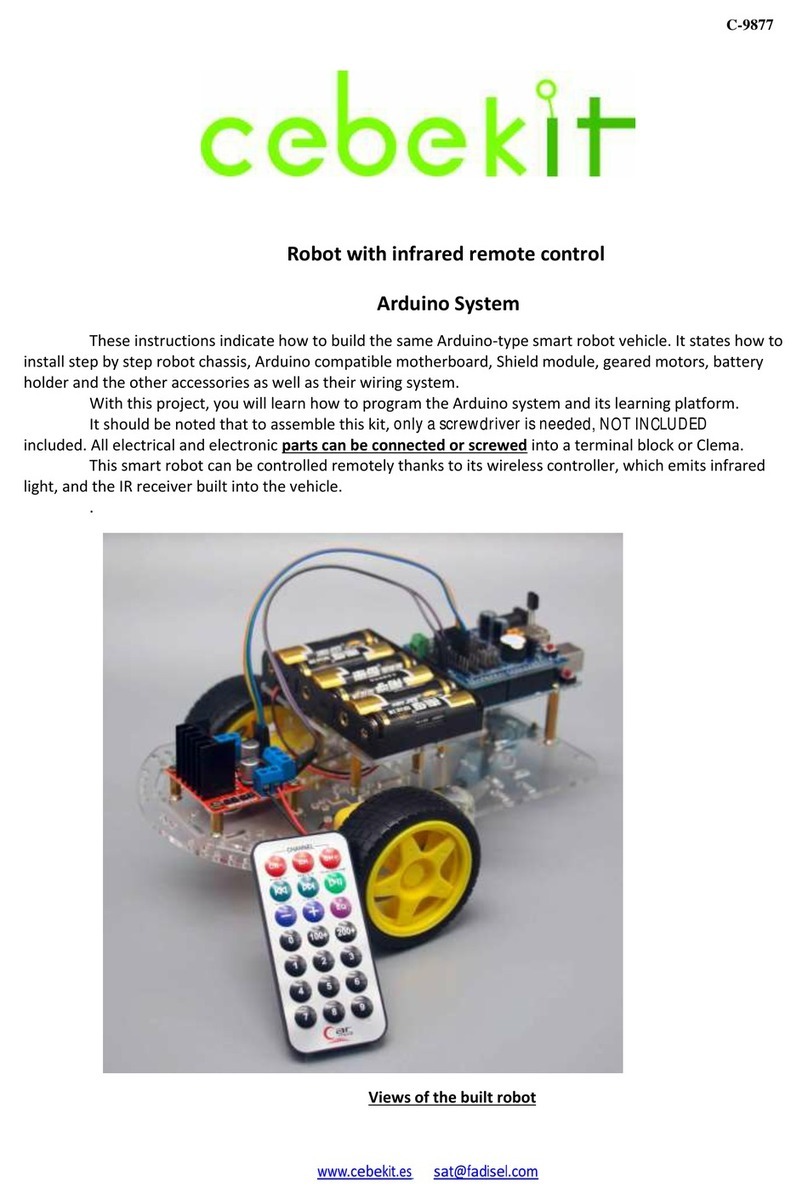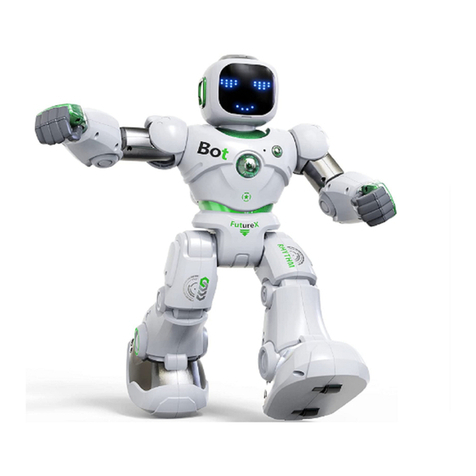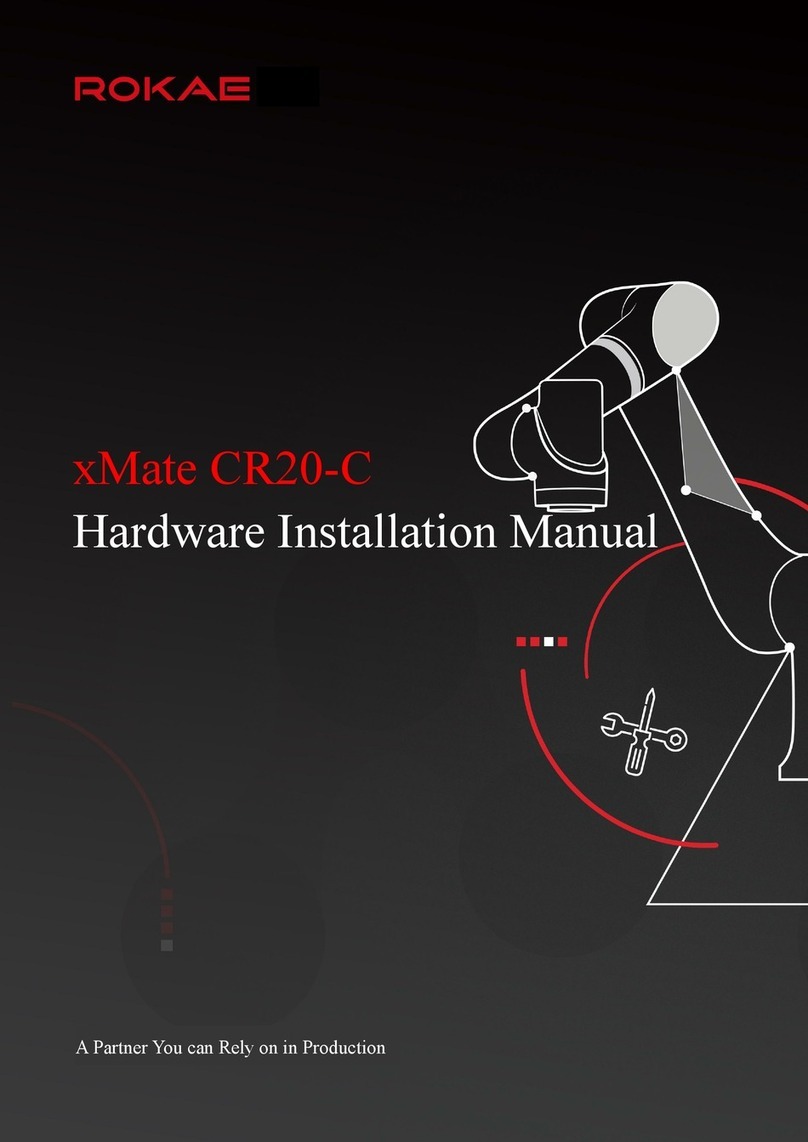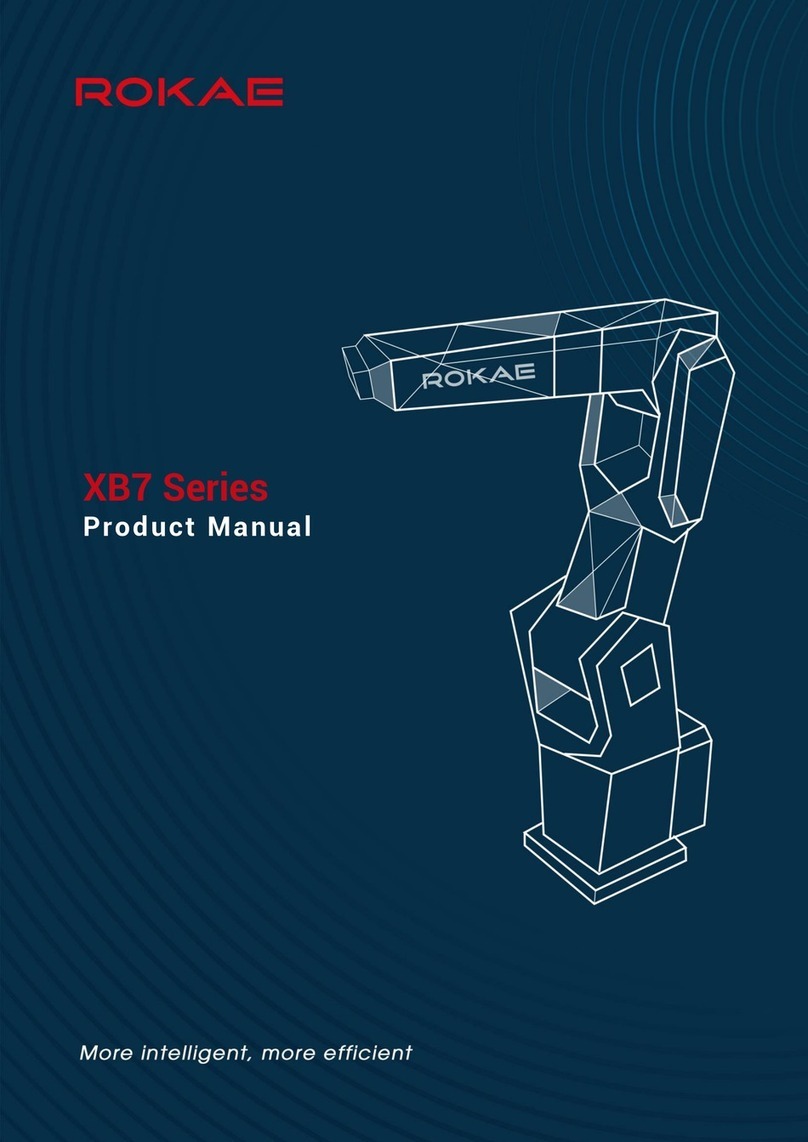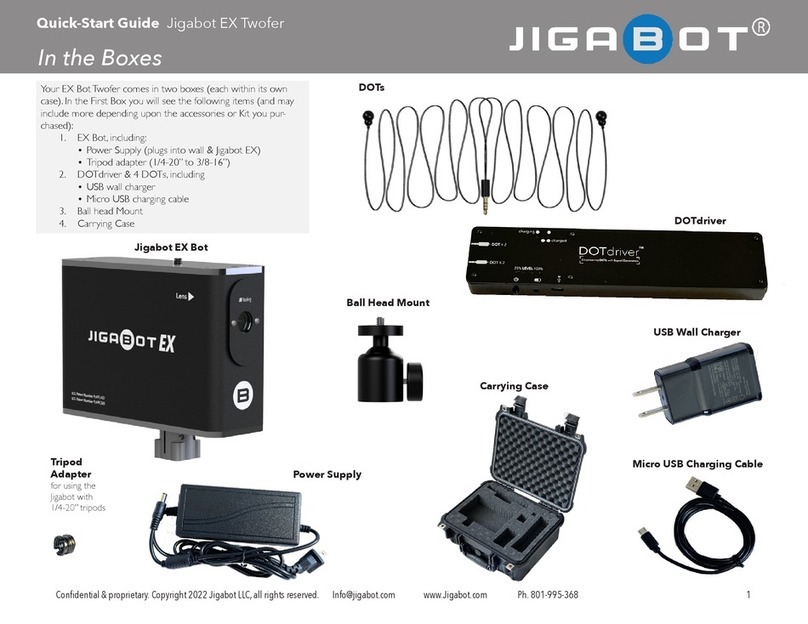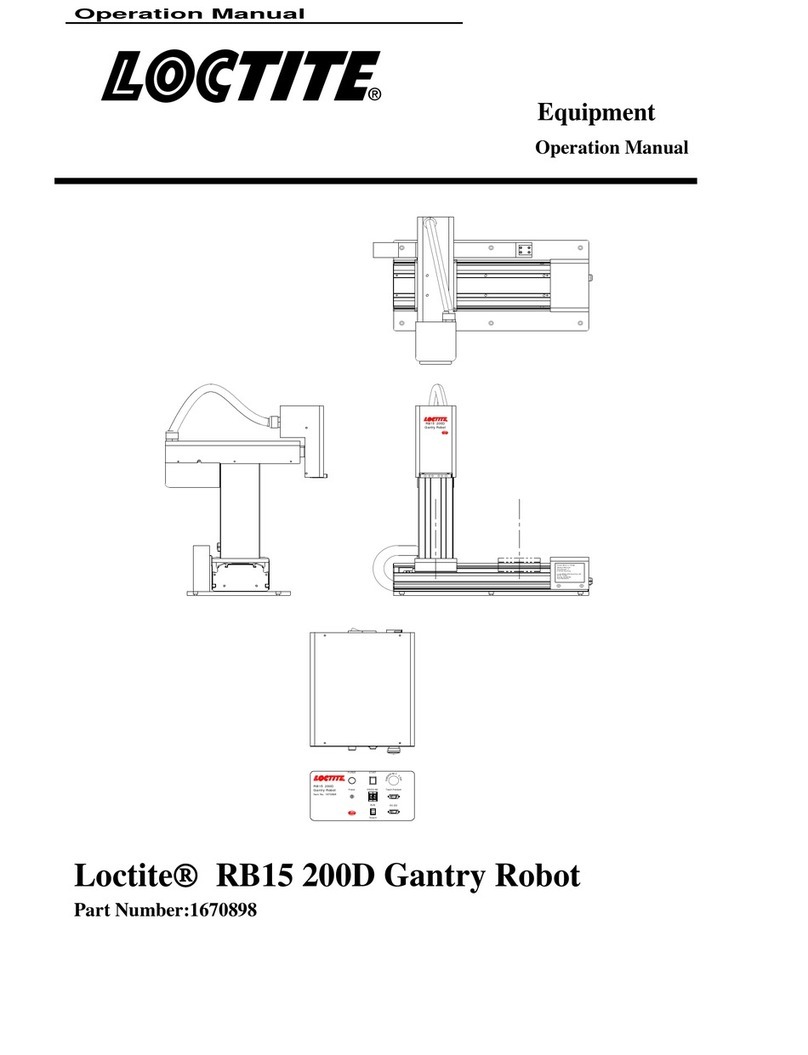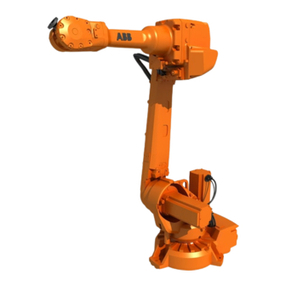TETRIX Tele-Op User manual

Hardware Connections
1. Connect one end of the Powerpole extension cable to the other battery
connection port on PRIZM. Connect the other end of the Powerpole
extension cable to the battery connection port on the Tele-Op module.
2. Connect one end of the daisy-chain data cable to the I2C expansion
port on PRIZM. Connect the other end of the daisy-chain data cable to
the I2C port on the Tele-Op module.
3. Choose a location on the TaskBot to attach the Tele-Op module.
Make sure that the location is close enough to PRIZM that the power
connection cable and the daisy-chain data cable will reach between the
Tele-Op module and PRIZM. Attach the Tele-Op module using leftover
socket head cap screws and kep nuts from your TETRIX MAX set.
4. This activity uses the motor encoders built into the TETRIX MAX
TorqueNADO® Motors. Connect one end of a motor encoder cable to a
TorqueNADO motor. Connect the other end of the cable to the encoder
port on PRIZM that corresponds to the motor port for that motor
(Motor 1 to Encoder Port 1, Motor 2 to Encoder Port 2).
5. Make sure that the Ultrasonic Sensor on the TaskBot is connected to
Port D2 on PRIZM.
6. Make sure that the Line Finder Sensor is connected to Port D3 on
PRIZM.
7. Make sure that the servo that raises and lowers the ag on the TaskBot
is connected to Servo Port 1 on PRIZM.
Tele-Op Module Activity 2 – TaskBot Control
Parts Needed
• Built TETRIX® MAX TaskBot from PRIZM
Programming Guide
• Tele-Op module
• PS4 DUALSHOCK 4 gaming controller
• Powerpole extension cable
• Daisy-chain data cable
• 2 motor encoder cables
• USB cable
• Socket head cap screws
• Kep nuts
Overview
In this activity, you will understand how the Tele-Op module enables you to control
a robot using the buttons, triggers, joysticks, and sensors associated with the PS4
DUALSHOCK 4 gaming controller. You will first need to build the TaskBot using
instructions from the PRIZM® Programming Guide. The TaskBot should include
the PRIZM controller, the Line Finder and Ultrasonic Sensors, and the servo/flag
attachment that is used for the final activity in the PRIZM Programming Guide.
TETRIX Tele-Op Control Module Activity 2 1

Bluetooth Connections
1. Make sure all devices that your PS4 controller has previously been
paired with are o. This enables the PS4 controller to search for and
connect to your Tele-Op module.
2. Make sure the PS4 controller is o.
3. Plug the Bluetooth dongle into the Tele-Op module’s USB port.
4. Turn on the PRIZM controller. The PRIZM controller and the Tele-Op
module should both have a blue LED that lights up, indicating they
have power. You should also notice a green ashing LED on the Tele-
Op module, indicating that the Bluetooth dongle is compatible. If
you do not see a green ashing light, then no Bluetooth dongle is
connected or the dongle is not compatible with the Tele-Op module.
Refer to the Tele-Op technical guide for more information on Bluetooth
compatibility.
5. To pair the PS4 controller with the Bluetooth dongle, the controller
must be put into discovery mode. On the PS4 controller, hold down the
Share and the Power buttons at the same time for about ve seconds
until you see the controller's light bar ash white in a rapid pattern. The
controller is now in discovery mode.
6. Press the black button on the Tele-Op module. The green LED on the
Tele-Op module should remain on and stop ashing. Also, the light bar
on the game controller should be a solid green color to indicate the
controller is paired and ready to be used to control the Tele-Op module.
7. After the PS4 controller has been paired with the Bluetooth dongle in
the Tele-Op module, you don’t need to go through this process again
unless you want to pair a dierent device or Bluetooth dongle. Simply
turn on PRIZM and the Tele-Op module and then press the Power
button on the PS4 controller. The controller will automatically connect
to the Bluetooth dongle in the Tele-Op module.
Note: When you connect the PS4
controller to the Tele-Op module,
the game controller pairs with the
Bluetooth dongle that is inserted
into the Tele-Op module’s USB
port. If you remove the dongle
from one Tele-Op module and
plug it into another, the game
controller can now be used
to control the second Tele-Op
module.
Note: When you turn off power
to PRIZM and the Tele-Op
module, the PS4 controller will
automatically turn off after about
10 seconds.
2TETRIX Tele-Op Control Module Activity 2

Opening the Sketch
On your computer, open the Arduino Software (IDE). The sketch for this activity is
stored with the examples that come with the Tele-Op library. To open the sketch,
select File > Examples > TETRIX_TeleOp > PS4_Examples > TaskBot_Activity_1.
A new sketch window will open with the example sketch.
Executing the Code
1. Connect the USB cable to a USB port on your computer or device.
Connect the other end of the cable to the USB port on PRIZM.
2. Make sure the PRIZM and Tele-Op module are turned on and that your
PS4 controller is paired with your Tele-Op module. There should be a
solid green LED showing on both the PS4 controller and the Tele-Op
module.
3. In the Arduino Software (IDE), make sure the correct COM port is
selected to communicate with PRIZM. Go to Tools > Port and then
select the correct COM port.
4. In the software window, click the Upload button to upload the sketch.
After the sketch has been uploaded, unplug the USB cable from PRIZM.
5. Start the program by pressing the green Start button on PRIZM. You
should now be able to control the movement of the TaskBot using the
PS4 controller. Try out these dierent controls.
Set Motor Power
Drag your finger across the touch pad from left to right to set the speed of your
motors. The further you drag to the right, the faster your motors will turn. You can
adjust the speed at any time by touching a different position on the touch pad.
Tank Drive Navigation
Use the joysticks to drive the TaskBot around. The left joystick should control
the left motor and the right joystick should control the right motor. If they are
opposite, turn off your TaskBot. Switch the motor ports and encoder ports that each
TorqueNADO is plugged into, turn your TaskBot back on, and restart the program.
You should find that the farther you push the joysticks up, the faster the TaskBot will
move forward. The farther you pull the joysticks down, the faster the TaskBot will
move backward.
Direction Pad Control
You can also steer the TaskBot using the four buttons on the direction pad. This
enables you to steer the TaskBot with your left hand while freeing up your right
hand to press other buttons.
90-Degree Turns
To make a 90-degree turn, press the L2 or R2 button. Using the encoders, the
TaskBot will automatically perform a 90-degree turn to the left or right.
Crawl Mode
While driving the TaskBot, hold down the L1 button to enter crawl mode. This
cuts the motor power down to 15% of its current speed, slowing the robot down.
Although the robot is much slower in crawl mode, you have much more precise
control of the robot to get it to go exactly where you want it to go.
Turbo Mode
While driving the TaskBot, hold down the R1 button to enter turbo mode. This
increases the motor power to a full 100 percent of the speed set by the PS4’s touch
pad. Turbo mode enables you to move your TaskBot much faster but makes it more
difficult to have precise control.
Note: The Tele-Op module has a
USB port that is used to flash its
firmware. This USB port should not
be used when uploading sketches.
Make sure you use the USB port
on PRIZM. Uploading a sketch to
the Tele-Op module will overwrite
its firmware, making it unusable
until it can have its firmware
flashed again.
Note: Due to wheel slippage,
you might notice the TaskBot not
making an exact 90-degree turn.
The friction between the wheel
and the surface you are driving on
is always an issue when trying to
make precise movements.
TETRIX Tele-Op Control Module Activity 2 3

Pitch and Roll Mode
You can also use the PS4 controller’s internal gyroscope to control your TaskBot.
Hold down the L1 and R1 buttons at the same time to enter pitch and roll mode.
While continuing to hold these buttons down, tilt the controller forward to move
forward, back to go backward, left to turn left, and right to turn right.
Line-Following Mode
Drive the TaskBot up to a line so that the Line Finder Sensor is directly over the line.
The TaskBot should line up with the line so that it faces the same direction that
the line goes. Hold down the L2 and R2 buttons at the same time to enter line-
following mode. You should see the TaskBot start following the line.
Raising the Flag
Use the Cross, Square, Triangle, and Circle buttons to set the flag to different
positions.
Proximity Warning
While driving the TaskBot, you might notice that the PS4 controller will vibrate
if you get too close to an object. Using the Ultrasonic Sensor to detect distance,
PRIZM will turn on the PS4 rumble motors if an object comes within 50 centimeters.
Closer than 50
centimeters
Box or obstacle
4TETRIX Tele-Op Control Module Activity 2

Moving Forward
After you’ve experimented with the different methods of controlling the TaskBot
using the PS4 controller, it’s time to dig into the code that runs the TaskBot. Look at
the code for the TaskBot_Activity_1 sketch in the Arduino Software (IDE). The code
is broken down into eight sections.
Initialization
The beginning of the sketch starts by including the PRIZM and Tele-Op libraries and
creating instances within each library class so that we can use the library functions.
This section also has all the global variable declarations. Recall that a global variable
can be used anywhere in the sketch. Four of the variables are float-type variables
that allow the use of decimal values. This is important for setting the percentages of
the motor power for the turbo (100%), crawl (15%), and normal (35%) modes.
There are also four integer variables – one for storing the xvalue from the touch
pad, one for storing the distance measured by the Ultrasonic Sensor to operate
the PS4 controller’s rumble motors, and two for storing the unique byte values of
different button combinations.
void setup()
The void setup() section has two new commands related to the Tele-Op module.
The ps4.setDeadZone commands set the size of the dead zones for the left and
right joysticks on the PS4 controller. By setting a dead zone, you identify the size of
an area for the joystick’s x- and y-axis that is considered neutral. When the joystick
returns to this neutral dead zone area, the joystick is considered to be centered.
Setting a higher dead zone value gives you a bigger neutral area but reduces the
sensitivity of the joystick outside the dead zone. On the other hand, a small dead
zone gives you more precise sensitivity but reduces the neutral area of the joystick.
TETRIX Tele-Op Control Module Activity 2 5

void loop()
The main loop starts with the ps4.getPS4() command. This command gets the
status of all the PS4 controller’s buttons, triggers, joysticks, and sensors and returns
the information to PRIZM. This command needs to be frequently repeated so
that as the user uses the controller, the status of what buttons are pressed gets
communicated to PRIZM.
The first if statement determines if there is an obstacle within the designated
detection range of the Ultrasonic Sensor. If the sensor detects an obstacle, the PS4’s
rumble motors are turned on. Otherwise, they are stopped.
The second if statement determines if there is a difference between what is stored
in the touchx variable and the current xvalue of the PS4’s touch pad. The
ps4.Touchpad(TOUCHX) command is what returns the xvalue of the touch pad.
If there is a difference between these two values, then the touchPadControl()
function is called. Otherwise, this function is skipped over. The touchPadControl()
function is where the speed of the motors are set using the touch pad.
Next, there are three while loops. These while loops determine if certain button
combinations are pressed. The ps4.buttons_1 command returns a unique byte
value depending on which buttons are pressed from Group 1. Group 1 buttons
include L1, L2, R1, R2, Triangle, Square, Circle, and Cross. Like Group 1, the
ps4.buttons_2 command also returns a unique byte value based on which buttons
from Group 2 are pressed. Group 2 includes the Up, Down, Left, Right, L3, R3, Share,
and Options buttons.
The first while loop will continuously call the lineFollow() function if the value
returned from ps4.buttons_1 equals the lineBtnCombo variable, which is 5. Five
is the unique value for when both the L2 and R2 buttons are pressed at the same
time. To simplify, the sketch will continuously run the lineFollow() function if the L2
and R2 buttons are both pressed.
Similar to the first while loop, the second while loop continuously calls the
pitchRollControl() function when the L1 and R1 buttons are pressed. When
these two buttons are pressed, the ps4.buttons_1 command will return 10,
which is the same value that is set for the pitchRollBtnCombo variable, and the
pitchRollControl() function is executed.
The third while loop is for controlling the robot with the direction buttons. The
direction buttons are part of Group 2, which is why ps4.buttons_2 is used. The only
time ps4.buttons_2 returns 0 is when none of the buttons in Group 2 are pressed.
This while loop uses a not (!=) comparison to say, “while not none of the buttons in
Group 2 are pressed, call the directionButtonControl() function.” Not none doesn’t
make a lot of sense in English, but in coding, a double negative makes a positive
just like it does in math. So in other words, this while loop says, “while at least one
of the Group 2 buttons is pressed, call the directionButtonControl() function.”
6TETRIX Tele-Op Control Module Activity 2

Following the three while loops, we have a function call for adjustMotorPowers().
This function determines if the TaskBot should be in crawl mode, normal mode, or
turbo mode. This function will be explained in further detail a little later.
The next command line is for driving the TaskBot with the joysticks. This command
sets the motor power level based on the vertical positions of the left (for the left
motor) and right (for the right motor) joysticks. The commands ps4.Motor(RY)
and ps4.Motor(LY) get the yvalues of the joysticks and map these values to
motor power values between -100 for all the way down and 100 for all the way up.
However, these joystick positions are multiplied by the powerMultiplier variable.
The powerMultiplier variable is either 15% (0.15) for crawl mode, 35% (0.35) for
normal mode, or 100% (1.00) for turbo mode. This reduces the maximum speed of
the motors when in crawl mode or normal mode.
The L2 and R2 buttons are used to turn the TaskBot left or right by 90 degrees. The
next three lines of the main loop provide this functionality.
The first if statement turns the TaskBot left, and the second if statement turns
the TaskBot right. The command ps4.Button(BUTTON)will return 1 if BUTTON is
pressed or 0 if BUTTON is not pressed. In this command, BUTTON can be any of the
following PS4 buttons:
These if statements also use motor encoder commands to turn the motors
a specified number of degrees (+ or - 270 degrees) at a specified speed (360
degrees per second). Notice that each if statement also includes a delay to wait
for the motors to complete the command before continuing with the loop. After
completing the turn, the encoders are reset for the next iteration of the loop.
The last four lines of the main loop are used to control the servo that raises and
lowers the flag. These if statements use the same ps4.Button(BUTTON)command
to check the status of the Cross, Square, Triangle, and Circle buttons. When one of
these buttons is pressed, the servo that controls the flag is set to a corresponding
position.
• L1
• L2
• L3
• R1
• R2
• R3
• UP
• DOWN
• RIGHT
• LEFT
• TRIANGLE
• CROSS
• CIRCLE
• SQUARE
• SHARE
• OPTIONS
• POWER
• TOUCH
TETRIX Tele-Op Control Module Activity 2 7

void adjustMotorPowers()
This called function determines the speed of the TaskBot based on whether the
user wants to be in crawl mode, normal mode, or turbo mode. It is composed
of a three-part conditional statement that runs one of three sets of commands.
The if statement determines if the L1 button is pressed using the ps4.Button(L1)
command. If the L1 button is pressed, the powerMultiplier variable is set to the
lowSpeed value (0.15, or 15%) and the LED on the PS4 controller is changed to red.
If the L1 button is not pressed, then the second part of the conditional statement
is checked – the else if part. This statement determines if the R1 button is pressed
using the ps4.Button(R1) command. If the user presses the R1 button for turbo
mode, then the powerMultiplier is set to the highSpeed value (1.00, or 100
percent). The PS4’s LED is also set to green.
If neither of the first two conditions are met, then a third set of commands is
executed – the else part. Since the user does not want crawl mode or turbo mode,
then the only other option is normal mode. The powerMultiplier is set to the
medSpeed variable (0.35, or 35%), and the PS4’s LED is set to yellow.
void touchPadControl()
The touchPadControl() function sets the maximum speed of the TaskBot using the
PS4’s touch pad. The command ps4.Touchpad(TOUCHX) returns a value of 0 to
1920 depending on the x-coordinate of where the user last touched the PS4’s touch
pad. This value is stored in the touchx variable so it can be used later.
Because the touch pad can go all the way up to 1920 but our motors have a max
power of only 100, the map function is used to set the highSpeed variable to a
value between 0 and 100. Then, the highSpeed variable is converted to a decimal
number between 0 and 1 to represent a percentage of the maximum motor power.
After the highSpeed variable is set, the medSpeed and lowSpeed variables can
be set. The medSpeed variable is set to 35% of the highSpeed value, and the
lowSpeed variable is set to 15% of the highSpeed value.
8TETRIX Tele-Op Control Module Activity 2

void lineFollow()
The lineFollow() function gets called when the L2 and R2 buttons on the PS4
controller are pressed at the same time. Remember that in the main loop, this
function is called from inside a while loop. As long as the L2 and R2 buttons remain
pressed, the sketch will not break out of the while loop, and this function will
continuously be executed. This is why the first line of the function is the
ps4.getPS4(); command. Without this command, the button and joystick status of
the PS4 controller would never get updated, and the sketch would never break out
of the while loop. Including this command at the beginning of the function enables
the program to know when either the L2 or R2 button is released and the time to
stop line following.
The other three lines of code in this function should look familiar by now. The PS4
controller’s LED is set to blue to indicate the TaskBot is in line-following mode. The
two if statements read the Line Finder Sensor and cause the TaskBot to turn one
way if the sensor detects dark and the other way if the sensor detects white.
void pitchRollControl()
When the PS4 controller’s L1 and R1 buttons are pressed at the same time, the
TaskBot goes into pitch and roll mode, and this function is called from the main
loop. Similar to the LineFollow() function, this function is called from within a
while loop. The program will not break out of the while loop until either the L1 or
R1 button is released. Because of this, it is important to check the status of the PS4
controller’s buttons every iteration of the while loop. This is why the first command
inside the function is the ps4.getPS4() command. This command updates the
status of the controller’s buttons, joysticks, and gyroscope sensor values, and it is
the gyroscope sensor values that determine the pitch and roll.
TETRIX Tele-Op Control Module Activity 2 9

Also inside the function are two commands to change the color of the controller’s
LED. These two commands work together to cause the LED to flash between blue
and red, indicating that the TaskBot is in pitch and roll mode.
The TaskBot’s motors are controlled with the third command in this function.
Although it looks complicated, the prizm.setMotorPowers() command has just
two values in it: the power for Motor 1 and the power for Motor 2. These two values
are separated by the comma.
For Motor 1, the command adds the pitch and roll measurements from the PS4
controller’s gyroscope. For Motor 2, the controller’s roll measurement is subtracted
from the controller’s pitch measurement. The table below shows the TaskBot’s
behavior when the PS4 controller is tilted to its maximum tilt.
Notice that in the last two table entries, the TaskBot moves the opposite direction of
the controller tilt, but because of the backward motion, the TaskBot ends up facing
the direction of the tilt.
Controller Tilt Pitch Roll Motor 1
P + R
Motor 2
P - R Result Motion
All the way
forward 100 0100 100 Forward at full speed
(both motors forward)
All the way
backward -100 0-100 -100
Backward at full speed
(both motors
backward)
All the way left 0-100 -100 100
Rotate left/
counterclockwise
(left motor backward,
right motor forward)
All the way right 0100 100 -100
Rotate right/clockwise
(left motor forward,
right motor backward)
Forward and left 100 -100 0200
Pivot left forward
(left motor stationary,
right motor forward)
Forward and
right 100 100 200 0
Pivot right forward
(left motor forward,
right motor stationary)
Backward and
left -100 -100 -200 0
Pivot right backward
(left motor backward,
right motor stationary)
Backward and
right -100 100 0-200
Pivot left backward
(left motor stationary,
right motor backward
100
Pitch
Roll
100
-100
-100
10 TETRIX Tele-Op Control Module Activity 2

void directionButtonControl()
The last called function of the sketch is the function for controlling the TaskBot
using the PS4 controller’s direction pad. In the main loop, this function is called
from within the third while loop and is executed when one of the buttons from
Button Group 2 is pressed.
Because this function is called from within a while loop, it is necessary to include
the ps4.getPS4() command to update the status of the PS4 controller’s buttons,
joysticks and sensors.
Next, the function includes an if statement to determine if the value of the touch
pad has changed. If the user is using the touch pad to adjust the motor speed, then
the touchPadControl() function is called to adjust the crawl, normal, and turbo
mode speeds.
After that, the adjustMotorPowers() function is called to adjust the
powerMultiplier based on if the TaskBot is in crawl mode, turbo mode, or normal
mode.
Finally, the function uses eight if statements to determine which buttons from the
directional pad are pressed and to adjust the motors accordingly. The
ps4.buttons_2 command is used to get the uniquely assigned value based on
what button or buttons are pressed on the direction pad.
TETRIX Tele-Op Control Module Activity 2 11

Hacking the Code
Start a new sketch. Using the TaskBot_Activity_1 sketch as an example, program
the TaskBot to autonomously follow a line until an obstacle is detected with the
Ultrasonic Sensor. When an obstacle is detected, the TaskBot should stop moving
and wait for the user to take control using the PS4 controller to drive around
the obstacle and back to the line. When the TaskBot is back on the line, the user
should be able to press a button on the PS4 controller to have the TaskBot start
autonomously following the line again.
The table here shows the direction pad buttons, the unique value associated with
each button combination, and the resulting action when each button combination
is pressed.
Button Group 2 Value Group 2 Binary Value Action
1 1 Go forward
81000 Rotate left
210 Go backward
4100 Rotate right
91001
Pivot
forward
left
10 1010
Pivot
backward
right
6110 Pivot
backward left
5101
Pivot
forward
right
12 TETRIX Tele-Op Control Module Activity 2
Other manuals for Tele-Op
1
This manual suits for next models
1
Table of contents
